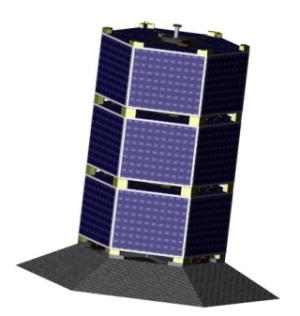Projects
3CS

Background
The Three Corner Satellite (3CS) project is a mission being developed jointly by Arizona State University, University of Colorado at Boulder, and New Mexico State University. 3CS consists of three coordinated satellites that will be deployed in a stack configuration from the Space Shuttle and will then separate to form a "virtual formation". The constellation will orbit at approximately 380 km with a 40-degree angle of inclination. The mission lifetime is estimated to be 2-4 months. The goals of the 3CS mission include the demonstration of stereo imaging, formation flying and innovative command and data handling.
The principal instrument on 3CS are digital cameras onboard each of the three spacecrafts. A total of twelve cameras (resolution 640 x 480) reside within the 3CS constellation, four onboard each spacecraft. It takes on the order of 1/30th of a second to take each image. Images will only be collected during daylight periods. Nominally we expect to collect 24 images per orbit resulting in 2.4 MB of image data per orbit. The storage capacity for the images is still being determined, but the current plan is to allow for onboard storage of 3 orbits worth of images. 3CS will utilize a PowerPC 750 flight processor.
Problem
Operating spacecraft in a ground-based mode prevents rapid response to science opportunities or anomalies due to transmission delays, contact schedules, and limited commuications bandwidth.
Impact
Onboard decision-making enables rapid response to science events to improve science, anomalies to reduce downtime. Onboard processing also enables low priority science data to be discarded, meaning that limited downlink can be more effectively used.
Status
The 3CS stack was originally slated for launch aboard the Space Shuttle in 2003, but after Shuttle Columbia tragedy, mission organizers switched to Boeing Delta IV Heavy rocket (it was its first launch). Due to a problem with the rocket during launch, 3CS failed to achieve orbit. Satellites were to have been dropped off at a low 180 km × 240 km, but they entered orbit at a height of only 105 km, which led to a rapid decay.
Publications
Team
JPL: Steve ChienRob Sherwood
Gregg Rabideau
Daniel Tran
Barbara Engelhardt
